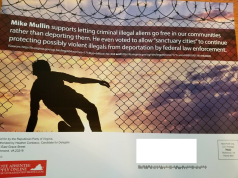Check out the video of Stewart Schwartz of the Coalition for Smarter Growth, speaking in Alexandria at the December 9 meeting of the Commonwealth Transportation Board (CTB), and the partial transcript below. Schwartz does a great job, in a short amount of time, of explaining why we need smart growth solutions in the I-66 corridor, and throughout Northern Virginia, NOT more roads and more roads-inducing sprawl development.
The CTB meeting at which Stewart Schwartz spoke covered a number of transportation-related topics, including this mouthful: “Authorization to Impose Tolls on I-66 Inside the Beltway, Advancement/Allocation of Toll Facilities Revolving Account Funds, and Approval of a Memorandum of Agreement with the Northern Virginia Transportation Commission Relating to the Transform66: Inside the Beltway Project.” What on earth is that? Well, if you followed the closing weeks of the 2016 Virginia General Assembly elections, or if you simply turned on your TV in those closing weeks, you’re almost certainly aware that the issue of I-66 tolling came up, over and over again, in the most demagogic and misleading fashion. I’d note that, in the end, despite Republicans spending hundreds of thousands of dollars on these ads, none of the candidates they attacked (Jennifer Boysko, Kathleen Murphy, etc.) lost. In fact, it’s arguable that the ads backfired, if anything, as candidates like Kathy Smith won by far larger margins than had been expected. So, not sure about the political potency of this line of attack, but it certainly didn’t work in 2015.
Anyway, the bottom line is that the McAuliffe administration is generally on the right course with regard to addressing traffic congestion on I-66 inside and outside the Beltway. As the Coalition for Smarter Growth and many others understand, the LAST thing we should want is pouring more pavement, for a wide variety of reasons, including: a) increasing road capacity simply encourages more sprawl and more traffic (“induced demand”); b) locking in, and even adding to, fossil-fuel-powered transportation infrastructure is the 180-degree wrong way to go, at a time when we need to be rapidly phasing out greenhouse gas emissions if we want to avoid frying our planet; c) building new roads is a ridiculously expensive proposition, and for no good reason (see points “a”and “b”), other than to line the pocket of the road-building folks.
As for the McAuliffe administration’s plan for the I-66 corridor, what it does is basically harness Free Market Economics 101 to address/ameliorate a problem in a cost-effective, market-oriented fashion. Why Republicans of all people would oppose this is kind of mind boggling, until you consider that they also have flip-flopped and now oppose other conservative ideas, such as the “individual mandate,” “cap-and-trade,” etc.
The bottom line, with regard to widening I-66 inside the Beltway, is that Arlington County is absolutely correct: this should be a last-ditch option, after all other options have been tried and ONLY if those other options fail. Frankly, widening I-66 is just as misguided and short-sighted as building new fossil-fuel-fired infrastructure, before we’ve maxed out on energy efficiency. Not smart at all.
With that, here are Stewart Schwartz’s comments at the Dec. 9 meeting of the CTB. Enjoy.
Regarding the previous speakers, they apparently don’t believe in the science of induced traffic, that it is a very real problem. They apparently think we can widen Constitution Avenue in DC. There is no place for these cars to go. If you build it, they WILL come on a wider road. That’s why your combined transportation demand management, transit, HOV solution is the best solution for that corridor.
And I get a little tired of the Arlington bashing. Arlington has probably done more to relieve traffic congestion in Northern Virginia than any other jurisdiction…Their transit-oriented development has sited millions of square feet of development, tens of thousands of housing units, in locations where their vehicle trips and vehicle miles traveled are lower than anywhere else in Northern Virginia. And they have, in the process, maximized transit, walking and biking. That IS a regional transit-oriented development…not what I’m hearing, which is a 1950s, can-we-please-build-rings-of-outer-beltways-and-widen-every-road.
We have to change our land use to do so in a more sustainable way…We DO care about the regional economy, we DO care about being competitive. That means we should maximize great placemaking and transit-oriented development to attract these companies, to retain the Millenials and the next-generation creative employees. And we should do our transportation smart, in a demand-management way like we’re talking about…










![Saturday News: “Trump’s latest tariff TACO probably won’t make your life more affordable”; “The Epstein Email Cache: 2,300 Messages, Many of Which Mention Trump”; “[MTG] questions if Trump is still the ‘America First’ president”; “Jim Ryan tells all: ‘What did the Governor know, when did he know it?’”](https://bluevirginia.us/wp-content/uploads/2025/11/montage1115-100x75.jpg)
